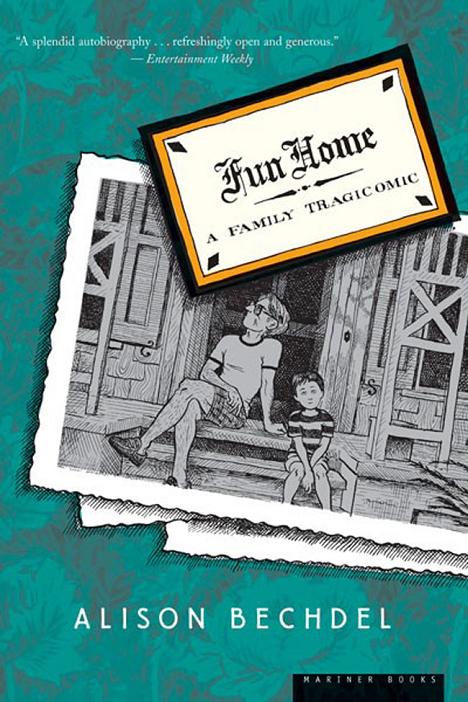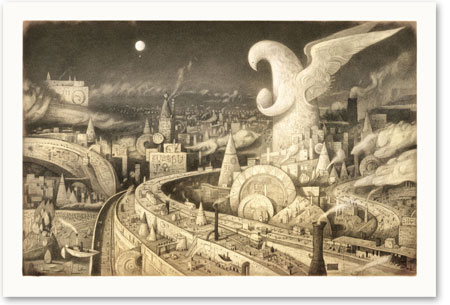Alison Bechdel's "Fun Home"
It's safe to say that of all the different forms of graphic novel my graphic narrative course planed on covering this quarter, the graphic memoirs were the ones I was hotly anticipating.
I wasn't disappointed.
The "graphic" aspect of the graphic memoir acts gives the narrative a whole new direction in which to expand; contradicting, enforcing, analyzing, and clarifying the ideas offered by the text. Graphic memoir is one of the fastest growing sub-genres in graphic narrative, and understandably so. Franco-Belgian artist David B. and the USA's own Alison Bechdel are two of the more prominent names in graphic memoir. B's "Epileptic" and Bechdel's "Fun Home" show the diverse and wonderful ways that graphic memoir succeeds in capturing the reader's heart and mind.
 David B's "Epileptic" follows the journey of David and his family as they struggle to understand and deal with David’s older brother Jean-Christophe’s epilepsy. B’s clean line style, use of dark space, and intricate detail in his panels allow the reader to function inside B’s memory. One one level, B's text boxes give the reader the adequate information to understand David's situation in life and his feeling on Jean-Cristophe's illness. It is the images, however, that accompany the words that craft an intimate relationship between reader and writer and allow us, as readers, to truly understand B's experience. The best example of how this works is the way in which B's draws his brother. Early in the narrative Jean-Christophe appears as a normal boy, just like David. As his epile
David B's "Epileptic" follows the journey of David and his family as they struggle to understand and deal with David’s older brother Jean-Christophe’s epilepsy. B’s clean line style, use of dark space, and intricate detail in his panels allow the reader to function inside B’s memory. One one level, B's text boxes give the reader the adequate information to understand David's situation in life and his feeling on Jean-Cristophe's illness. It is the images, however, that accompany the words that craft an intimate relationship between reader and writer and allow us, as readers, to truly understand B's experience. The best example of how this works is the way in which B's draws his brother. Early in the narrative Jean-Christophe appears as a normal boy, just like David. As his epile psy begins to manifest itself and cause the family more problems B's begins to draw a dragon/snake like creature writhing around Jean-Christophe. Eventually David doesn't even need to include the image of Jean-Christophe in panels, using the image of this all consuming dragon like creature to represent the overwhelming burden of
psy begins to manifest itself and cause the family more problems B's begins to draw a dragon/snake like creature writhing around Jean-Christophe. Eventually David doesn't even need to include the image of Jean-Christophe in panels, using the image of this all consuming dragon like creature to represent the overwhelming burden of
Jean-Christophe's epilepsy. He utilizes the black and white format, playing off the high contrast between black and white making the characters pop off the page in their brightness, drawing our eye to the beautifully intricate detail of the work.
 Alison Bechdel's "Fun Home" is perhaps one of the most well received graphic narratives since Art Spiegelman's "Maus". "Fun Home" is Bechdel's journey of coming to terms with her father; both his life, their relationship, and his death. "Fun Home" works in some surprisingly different ways than B's "Epileptic". First and foremost, this is a very text-heavy graphic narrative. The few critics of this graphic memoir claim this is a memoir fighting to be graphic, meaning the pictures are secondary to the text. Yes, the textual narrative is very strong in "Fun Home", but the visual narrative lends that essential "other" level, the level that contradicts, creates, enforces, elaborates the textual narrative. Nowhere is this more apparent then in the last panel. The text reads "But in the tricky reverse narration that impels our entwined stories, he was there to catch me when I leapt" then shows here leaping into her father's arms. This image is startling because it is a different view of an image that begins the chapter, allowing the viewer to take both the change in image and the adjoining text and understand the importance of the memory.
Alison Bechdel's "Fun Home" is perhaps one of the most well received graphic narratives since Art Spiegelman's "Maus". "Fun Home" is Bechdel's journey of coming to terms with her father; both his life, their relationship, and his death. "Fun Home" works in some surprisingly different ways than B's "Epileptic". First and foremost, this is a very text-heavy graphic narrative. The few critics of this graphic memoir claim this is a memoir fighting to be graphic, meaning the pictures are secondary to the text. Yes, the textual narrative is very strong in "Fun Home", but the visual narrative lends that essential "other" level, the level that contradicts, creates, enforces, elaborates the textual narrative. Nowhere is this more apparent then in the last panel. The text reads "But in the tricky reverse narration that impels our entwined stories, he was there to catch me when I leapt" then shows here leaping into her father's arms. This image is startling because it is a different view of an image that begins the chapter, allowing the viewer to take both the change in image and the adjoining text and understand the importance of the memory.
I think graphic memoir may be one of the most perfect ways to capture memory. Memory is a tricky, fickle thing. It often includes all the contradictions, lapses, and elaborations that the visual side of graphic memoir so perfectly captures. The visuals also help enforce the textual narrative by offering an air of authenticity, in Bechdel's case, including depictions of real photographs and even copying her handwriting from when she was a child. The hardest thing for an essayist to do is convince his or her readers that what they are writing is honest and true. The combination of visual and textual information, as exemplified in "Fun Home" and " Epileptic", prove how moving and powerful the graphic memoir can be.
Until next time,
GN




